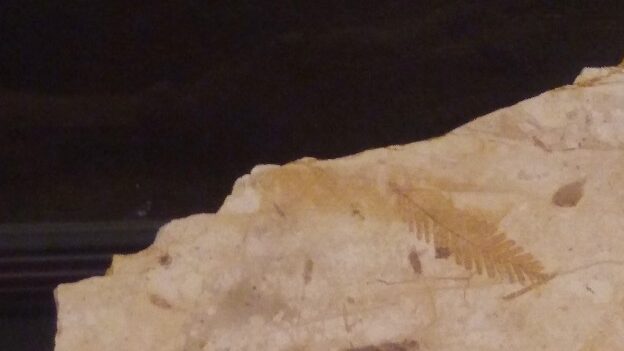In 2005, the Oregon Legislature adopted the Dawn Redwood Tree (Metasequoia) as Oregon’s state fossil. The story of how this came to happen and how a “living fossil” came to grow in Bush’s Pasture Park is a fascinating one.
Dawn Redwoods were common during the Paleocene and Eocene Epochs (beginning about 55 million years ago), growing as far north as northern Canada. They flourished for millions of years in Central Oregon. As the climate changed over time, the trees disappeared from North America, leaving behind only fossils of their delicate needles. The photo above shows a fossil of their delicate needles; it was found behind Fossil High School in Fossil, Oregon, and is displayed at the Thomas Condon Visitor Center in the John Day Fossil Beds National Monument.
In 1941, a Japanese paleobotanist (someone who studies ancient plants) named a new genus, Metasequoia, to describe fossils that were previously mis-identified as bald cypress. Because Japan was at war with much of Europe and North America, the new genus did not immediately make news here. Western scientists learned of the new genus only after World War II.
Meanwhile, in China, a forester found a grove of deciduous conifers in what was then Sichuan Province. He thought the trees were swamp cypress and gathered some samples, including cones, from the trees. After World War II, some of the samples ended up at Harvard’s Arnold Arboretum. The Director of the Arboretum matched the samples with the Metasequoia fossil genus discovered in 1941, and concluded that the Chinese forester had discovered a living fossil.
News about the Metasequoia living in China was published in the US in 1946. Scientists were excited about the news and collected over four pounds of seeds, which were supplied to botanists in the US and in the United Kingdom.
Eventually, the living trees were dubbed Metasequoia glyptostroboides. The genus comes from the Greek meta, meaning alike or akin, and Sequoia, the genus of the coast redwood, because the Dawn Redwood resembles a coast redwood. Glyptostroboides is the genus name of the Chinese swamp cypress that the forester initially confused with the living Dawn Redwood. The word “dawn” in the popular name is meant to remind us of the ancient lineage of the tree as reflected in the fossil record.
Hoyt Arboretum in Portland received seeds from the Chinese Metasequoia in 1948, shortly after they arrived in the US. In 1952, Hoyt Arboretum’s Dawn Redwood produced seed-bearing cones – the first time a Metasequoia had produced cones in North America in at least six million years!
Dawn Redwoods now thrive in many places around the US, including Wilson Park at the Oregon State Capitol, the Hoyt Arboretum in Portland, the Morton Arboretum in Chicago, the Arnold Arboretum at Harvard, and (most importantly) Bush’s Pasture Park in Salem. The trees can grow over 100 feet tall at a rate of one to two feet a year. They are deciduous, meaning they drop their needles every year, similar to larch trees.
In 2005, Rep. Alan Brown (R-Newport) introduced the bill that ultimately adopted the Metasequoiaas Oregon’s state fossil. HJR 3 (2005). The bill noted that Oregon already had a “state flag, a state animal (the beaver), a state flower (the Oregon grape), a state bird (the western meadowlark), a state seal, a state tree (the Douglas fir), a state fish (the Chinook salmon), a state gemstone (the sunstone) and a state rock (the thunderegg)”. Why not a state fossil? The bill passed by an overwhelming majority and the Metasequoia reigns today as Oregon’s one and only state fossil.
Dawn Redwoods were planted at Bush’s Pasture Park some time before 2000, but we have not yet nailed down the date. They sit on the edge of the Upper Pasture, just off High Street, and just south of the Ravine feature. Come say hello to the living fossil!
Thanks to Woody Dukes and Tom Beatty, who contributed to this article.
Written by Christine Chute.

